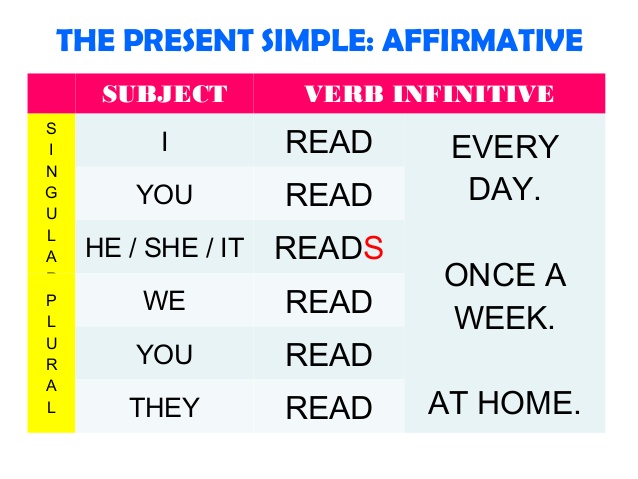In English language you can make sentences in affirmative and negative form. Look at the next picture and identify what is the diference that you notice in the verb READ.
Answer this question. What do you notice?
Please, leave your comments!
Now, pay attention to the following picture.





the difference is that the verb read when is used she, he and it the verb gtoes in plural.
ResponderBorrarIt is not in plural, only you add (s) to the verb with the third singular person.
Borrar
ResponderBorrarthe subjects of third person he, she, it and the verb if they are in infinitive form is added a (s)
I understood that she, it, he, the verb carries (s)
ResponderBorrarand that (I, YOU, WE AND THEY CARRY THEIR NORMAL VERB)
BUT I DID NOT UNDERSTAND THAT THERE WERE TWO: (YOU)
IN THE SECOND IMAGE I UNDERSTAND THAT THE VERBS THAT CARRY (S) ARE REFUSED AND ASKED WITH (DOES) AND THE VERBS THAT DO NOT TAKE (S) ARE THE THOSE WHO ARE REFUSED AND ASKED WITH (DO)
That´s right. You have to use the auxiliary (DO) only with: I, You, We and They for negative sentences and questions; and (DOES) with He, She ann It in the same way.
ResponderBorrarRemember that when you use the auxiliary the verbs remain in infinitive form or in their base form.
ResponderBorrarThe difference q there is between the it it is carry s in 3 person and we you they do not carry s it is written in its indifinitiva form
the difference is that when it is (I, They, You or We) does not carry (s) the verb remains in Its infinitive form.
ResponderBorrarAnd when It is (She, He, or It) carries (s)
the diference is that when it is : she, he or It carries (s) and when it is : I , we they or you do not carry (s) the verb remains in Its infinitive form
ResponderBorrarnow I know that the third person she he it carries (s) at the end
ResponderBorrarI learned that the third person is added at the end
ResponderBorrarI understood that the verb added to him when he is a third person
ResponderBorrar
ResponderBorrarIN THE IMAGE IT IS OBSERVED THAT WHEN THERE HE , SHE , IT IS USED WHEN THE VERB IS THIRD PERSON
I understood that when (I, they, you or us) do not carry (s) do not carry (s) by keeping in its imminent form
ResponderBorrarI understood the difference is that when it is (I, They, You or We) does not carry (s) the verb remains in Its infinitive form.
ResponderBorrarAnd when It is (She, He, or It) carries (s)
I learned a lot with the simple past
ResponderBorrarin third person (she, it, he) the verb carries s if the sentence is positive; when it is negative after the subject carries doesnot and when the sentence is interrogative does goes before the subject
ResponderBorrarwhen the sentence is positive in third person the verb carries one s and when it is negative and interrogative is added the does
ResponderBorrarEste comentario ha sido eliminado por el autor.
ResponderBorrarI understood the difference is that when it is (I, They, You or We) does not carry (s) the verb remains in Its infinitive form.
ResponderBorrarAnd when It is (She, He, or It) carries (s)
the difference is that when it is (I, They, You or We) does not carry (s) the verb remains in Its infinitive form.
ResponderBorrarAnd when It is (She, He, or It) carries (s)
1)
ResponderBorrarI UNDERSTAND THAT THE SUBJECTS SHE AND IT WHEN CARRIES A VERB IN INFINITIVE CARRIES (S), (ES) OR (IES) DEPENDING AS THE VERB
2)
I UNDERSTAND THAT THE (DO) AND AND (DOES) HELP THE WORD AND THEREFORE THE WORD IS IN INFINITIF FORM
ResponderBorrarthe difference that I notice in the image is that when a sentence goes (she, he, she) has to carry and when it is with (they, we, you) do not carry (s) and also the verb has to be in its normal or infinite form.
that the subject of third person he she it and the verb in infinity is put s
ResponderBorrarwhen the sentence is positive in the first person (I, you, they, we)
ResponderBorrarthe verb does not change, when it is negative takes the dont after the subject, and when it is interrogative the do go before the subject.
when they are (I, you, they or us) do not carry (s) the verb remains in its infinitive form.
ResponderBorrarand when they are (she, the, or it) carry (s)
when a prayer goes with they ,we,your, not take (s)
ResponderBorraris that when it is : she, he or It carries (s) and when it is : I , we they or you do not carry (s) the verb remains in Its infinitive form
ResponderBorrari think it's very good
ResponderBorrarespecially the video
ResponderBorrarEste comentario ha sido eliminado por el autor.
ResponderBorrarthe difference is that when it is (I, They, You or We) does not carry (s) the verb remains in Its infinitive form
ResponderBorrarwhen is writh with the leads (s)
ResponderBorrarwhen is i we,they
Los verbos HE/SHE/IT Se le agregan S
ResponderBorrarthe difference is that when it is (I, They, You or We) does not carry (s) the verb remains in Its infinitive form
ResponderBorrarLos verbos HE/SHE/IT LLEVAN (S)
ResponderBorrarLos verbos HE/SHE/IT LLEVAN (S)
ResponderBorrar